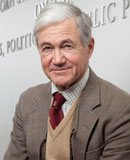
H.D.S. Greenway
Shorenstein Center Fellow, Spring 2012
Formerly, The Boston Globe
Excerpt:
When the Bush administration came into office, it was generally considered that domestic spying was off limits for the CIA and the National Security Agency (NSA), the ultra-secret agency tasked with electronic eavesdropping. Both had been in trouble before for keeping tabs on American citizens, but the rules had been tightened.
In the wake of 9/11, however, how could we be sure that our own citizens had not been drawn into the jihadist cause? Wouldn’t the new, unprecedented threat justify eavesdropping on Americans? “Basically all the rules were thrown out the window,” according to Adrienne Kinne, a former NSA employee, “and they would use any excuse to justify a waiver to spy on Americans.”¹
Thus was Stellar Wind born, an operation which resulted in an unprecedented encounter in the Oval Office between President George W. Bush and New York Times publisher Arthur Sulzberger Jr. over whether a news story should ever see the light of day.
According to William Binney, a former NSA cryptologist, Stellar Wind information was gathered through a network of windowless wiretapping rooms around the country, known as “switches,” which could gain access to international and domestic communications. AT&T and Verizon were drawn into an eavesdropping network of vast scale.
The Federal Intelligence Surveillance Act (FISA) had established courts to quickly provide warrants to intelligence agencies in the 70’s. But Stellar Wind bypassed that process. This was to be a warrantless wiretap, for reasons that have never adequately been explained. Perhaps, despite how easy warrants were to obtain, NSA decided that the process would be too restricting and complicated. Perhaps NSA just couldn’t be bothered. The disgruntled Binney would tell author James Bamford that “they violated the Constitution” setting up Stellar Wind “but they didn’t care. They were going to do it anyway, and they were going to crucify anyone who stood in the way.” Bamford alleged that the “NSA illegally…allowed wholesale monitoring of millions of American phone calls and emails.”
In the wake of the program’s exposure, Congress passed the FISA Amendment Act in 2008 which largely made the practices legal. But that does not address whether Stellar Wind was illegal when it was first set up after 9/11. To some, the 2008 FISA Act was akin to declaring a burglary legal after the burglars had been caught.
Was Stellar Wind illegal? The New York Times came to think so. But General Michael Hayden, who was head of NSA at the time, holds a different opinion. I asked him if he had any doubts. “I still say no,” he said. “The wiretaps were perfectly lawful and provided useful intelligence.”²
2. Hayden, Michael. Interview. March 5, 2012.

